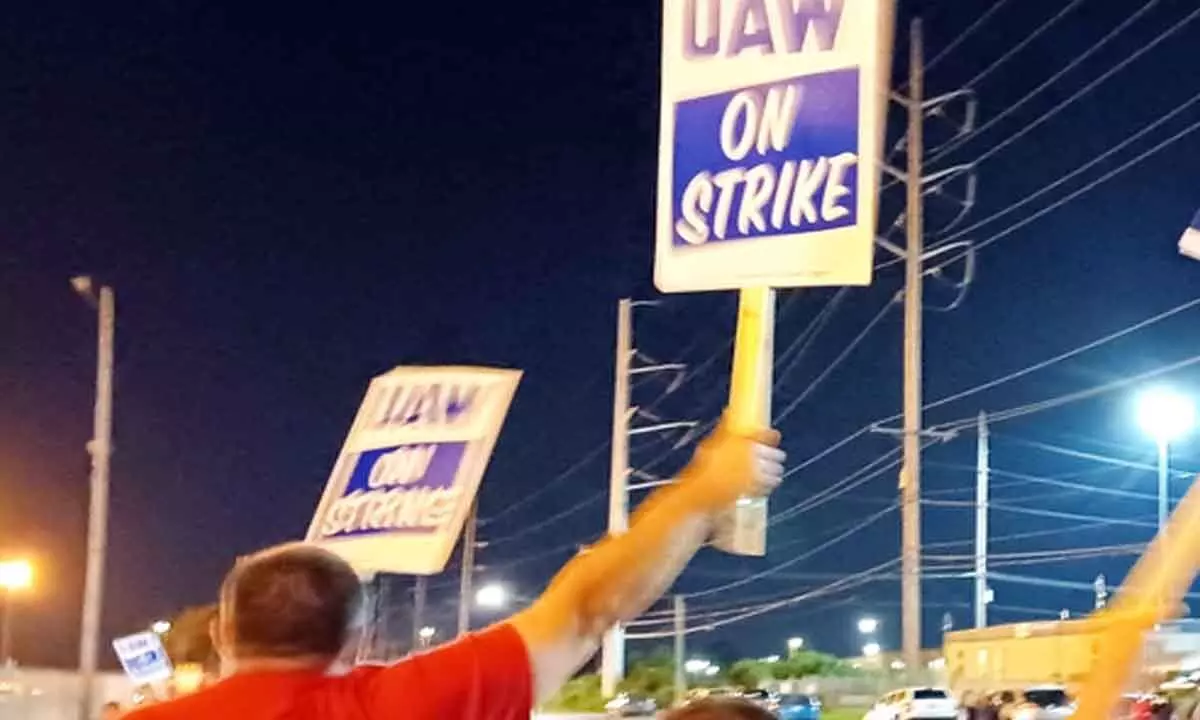Live
- CS inaugurates renovated SBI branch
- MyVoice: Views of our readers 11th January 2025
- Grandeur & enthusiasm mark Sankranti Sambaralu at ALC
- Will safeguard State’s cultural legacy, says Tejaswi
- 956 Chenchu families provided solar power: Minister
- AAP’s Toughest Battle Yet
- Hell Race - Border: The Ultimate Test of Endurance
- Naidu pledges to ignite real estate boom in Andhra
- The Viksit Bharat Young Leaders Dialogue 2025: Empowering Yuva Shakti
- Trump 2.0 Has Already The World On The Edge
Just In

This year saw a record of labour activities in the US, as the number of workers involved in strikes has reached at least 411,000, the highest since 2019, recent data showed.
This year saw a record of labour activities in the US, as the number of workers involved in strikes has reached at least 411,000, the highest since 2019, recent data showed.
According to data from the Bureau of Labor Statistics and Cornell University's Labor Action Tracker, workers have walked out from various industries such as automobile, healthcare, entertainment, hotel and airlines, reports Xinhua news agency.
This year's strikes also lasted longer than those in recent history.
More than 75,000 healthcare workers remain on the picket lines across the US on Friday, marking the industry's biggest strike in the country's history.
The healthcare workers' strike, which began on Wednesday, has entered its final day, but union leaders and their employer, the California-based non-profit healthcare organization Kaiser Permanente, haven't reached agreement on wages and solutions to staffing shortage.
After negotiations broke down on Wednesday, the two parties have scheduled additional sessions for October 12 and 13, the unions said on Friday.
Another major healthcare provider, Tenet Healthcare Corp., could be next to face a massive work stoppage, as healthcare workers at the company's 11 facilities plan to walk off the job starting October 23, if no deal is reached by October 19, according to their union.
The workers also asked for wage increases and solutions to staffing shortage.
The healthcare workers at Kaiser and Tenet are following in the footsteps of 7,000 nurses at two major hospitals in New York City, who took to the picket line early this year for similar demands.
Also on strike are more than 25,000 autoworkers from the "Big Three" automakers -- Ford, General Motors and Stellantis.
The workers have remained on strike since mid-September.
The United Auto Workers (UAW), which represents the striking workers, has expanded the strike twice, citing a lack of "meaningful progress".
The union has been adding striking workers in the past few weeks and said the number could grow if necessary.
The Hollywood walkout this year was the second-biggest work stoppage in the past 30 years, when the dual strikes by writers and actors are combined.
In terms of the number of striking workers, it is only next to the United Parcel Service (UPS) strike in 1997, which mobilised 180,000 delivery workers who stopped working for two weeks.
But the Hollywood strike lasted much longer. Starting May 2, some 11,500 Hollywood writers went on strike for nearly five months before the Writers Guild of America (WGA) reached a deal with major studios late last month.
The actors joined the strike in July and their union, which represents about 160,000 performers, is still in negotiations with studios and streaming companies.
Since July, about 20,000 hotel workers in southern California have walked off the job.
Union leaders are calling for better wages, improved health care, higher pension contributions, better safety protections and less strenuous workloads, among other benefits.
In late September, roughly 53,000 Las Vegas hospitality workers voted to authorise a strike as they started negotiations with hotels and casinos on new contracts.
At the end of August, 26,000 American Airlines flight attendants voted to authorise a strike if the company refuses to agree to "reasonable" contract terms.
Analysts said the rise in organized labor movements is partly due to the tight labor market and inflation.
The recent low unemployment rates have increased worker leverage, as many employers scrambled to compete for workers amid increasing resignations and early retirements.
Elevated inflation also has significantly eroded the buying power of salaries.
Although workers' pay has increased, most Americans' income hasn't grown as much as rent and grocery costs.

© 2025 Hyderabad Media House Limited/The Hans India. All rights reserved. Powered by hocalwire.com






